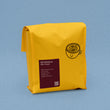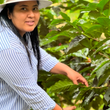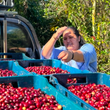
TECHNICAL DETAILS
Origin: Nicaragua, San Juan de Río Coco ( exactly here )
Process: Natural
Altitude: 1,2500 - 1,300 meters above sea level
Variety: Java
Producer: Several local producers
Harvest: 2022/23
Tasting notes: Earl grey, molasses, figs.
WHY WE LIKE IT
RECIPE
For filter:
We use 16 grams of ground coffee and 255 grams of final water at 93 ºC, in a total time of 2'25". We make five pours:
- Pour 50 gr of water in 30"
- Poured up to 110 gr of water in 1'
- Poured up to 170 gr of water in 1'30"
- Poured up to 230 gr of water in 1'45"
- Poured up to 255 gr of water in 2'25"
| EXPERIMENTATION VARIABLES | |
| Rest : 2 weeks (15-20 days) | |
| Method: V60 | |
| Mill : EK43 | |
| Water : Pentair Everpure 70ppm |
For espresso:
Use 17 grams of dry coffee to extract 44-46 grams of total drink in a cup in a time of 26 to 28 seconds.
| VARIABLES TO TAKE INTO ACCOUNT: | |
| Rest : 2 weeks (15-20 days) | |
| Temperature : 92.5ºC | |
| LaMarzocco Classic Line | |
| Mill : Mahlkonig E68S | |
| Scoops : VST 17g | |
| Water : Pentair Everpure 70ppm | |
| Pressure : 7 bars |
HISTORY
Nicaragua is located in the heart of Central America, forming part of that narrow belt that unites the two parts of the American continent. Its economy is based mainly on agriculture, among which productions such as corn, beans, bananas, pineapples and coffee stand out.
Although its origin in the country cannot be determined exactly, it is believed that the first coffee plantations were introduced by Spanish Catholic missionaries in the 18th century.
The Madriz region has stood out for the production of high quality coffees. With its high altitudes, volcanic soils, and its privileged tropical climate, it produces beans that have captivated coffee lovers around the world.
There is a strong commitment to the preservation of the environment. Producers have adopted sustainable and responsible agricultural practices, recognizing the importance of caring for natural resources and protecting the ecosystem in which precious grains are grown.
VARIETY AND PROCESS
The varietal of this lot is Java. It is a very common coffee variety in Central America, resistant to most pests and with little need for fertilization.
As its name indicates, the variety was introduced to the island of Java directly from Ethiopia by the Dutch at the beginning of the 19th century.
It first arrived in Latin America in the 90s, starting in Costa Rica and later spreading to the rest of the countries. However, the first Central American country to officially recognize Java was Panama in 2016. The quality potential of Java was later discovered when cultivated at high altitudes.
It represents an interesting alternative to Geisha, of high quality in the cup but more resistant to diseases and ideal for small farmers. Java beans normally attract the attention of consumers due to their large size once roasted.
This batch followed a natural process, drying for 33 days in raised beds in a greenhouse.







